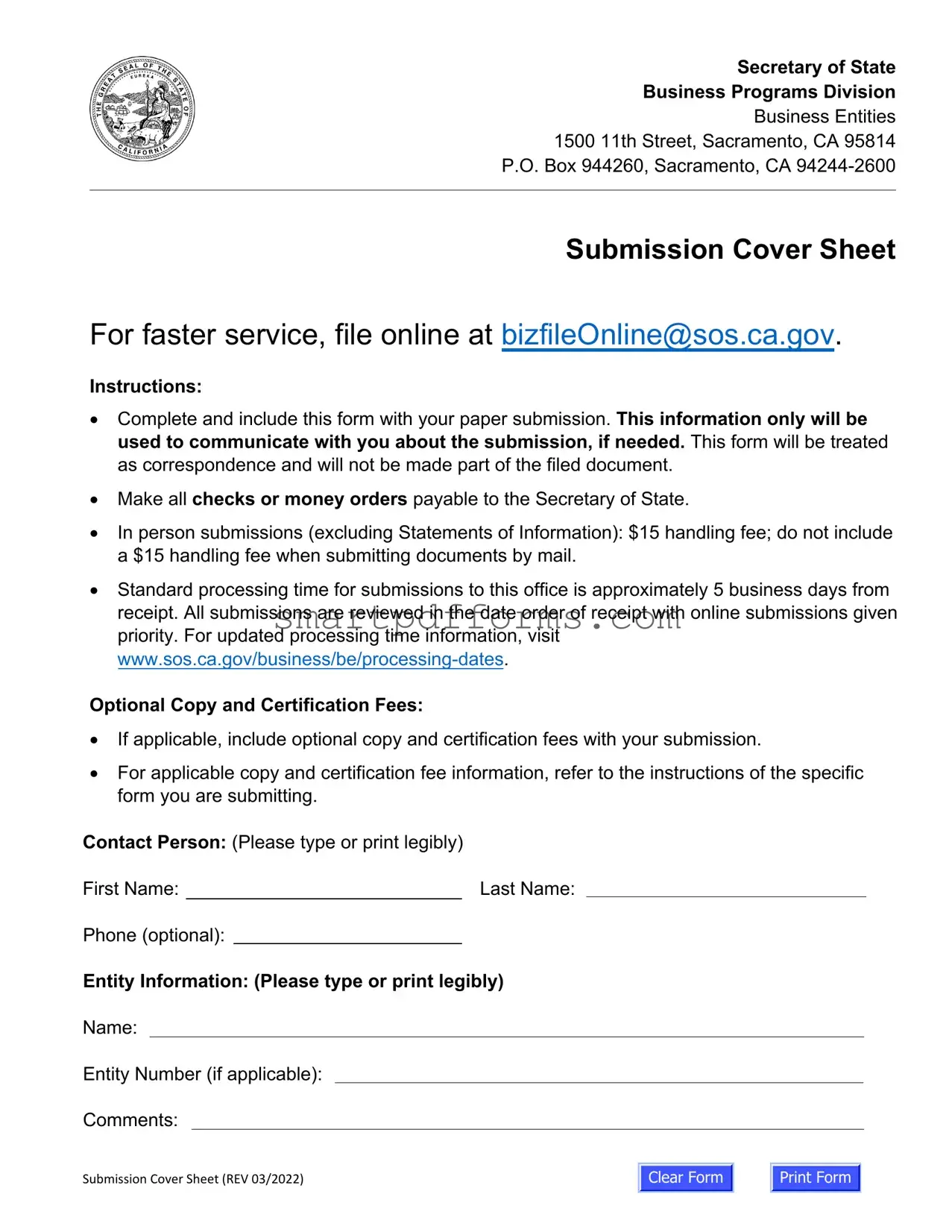
Secretary of State
Business Programs Division
Business Entities
1500 11th Street, Sacramento, CA 95814
P.O. Box 944260, Sacramento, CA 94244-2600
Submission Cover Sheet
For faster service, file online at bizfileOnline@sos.ca.gov.
Instructions:
•Complete and include this form with your paper submission. This information only will be used to communicate with you about the submission, if needed. This form will be treated as correspondence and will not be made part of the filed document.
•Make all checks or money orders payable to the Secretary of State.
•In person submissions (excluding Statements of Information): $15 handling fee; do not include a $15 handling fee when submitting documents by mail.
•Standard processing time for submissions to this office is approximately 5 business days from receipt. All submissions are reviewed in the date order of receipt with online submissions given priority. For updated processing time information, visit www.sos.ca.gov/business/be/processing-dates.
Optional Copy and Certification Fees:
•If applicable, include optional copy and certification fees with your submission.
•For applicable copy and certification fee information, refer to the instructions of the specific form you are submitting.
Contact Person: (Please type or print legibly)
Phone (optional):
Entity Information: (Please type or print legibly)
Name:
Entity Number (if applicable):
Comments:
Submission Cover Sheet (REV 03/2022)

Articles of Organization
Limited Liability Company (LLC)
Filing Fee – $70.00
Certification Fee (Optional) – $5.00
Note: LLCs may have to pay minimum $800 tax to the California Franchise
Tax Board each year. For more information, go to https://www.ftb.ca.gov.
This Space For Office Use Only
1.Limited Liability Company Name (Must contain an LLC identifier such as LLC or L.L.C. “LLC” will be added, if not included.)
2.Business Addresses
a. Initial Street Address of Designated Office in California - Do not enter a P.O. Box |
City (no abbreviations) |
State |
Zip Code |
|
|
CA |
|
b. Initial Mailing Address of LLC, if different than item 2a |
City (no abbreviations) |
State |
Zip Code |
3.Service of Process (Must provide either Individual OR Corporation.)
INDIVIDUAL – Complete Items 3a and 3b only. Must include agent’s full name and California street address.
a. California Agent's First Name (if agent is not a corporation) |
|
Middle Name |
Last Name |
|
Suffix |
|
|
|
|
|
|
b. Street Address (if agent is not a corporation) - Do not enter a P.O. Box |
City (no abbreviations) |
|
State |
Zip Code |
|
|
|
|
CA |
|
|
CORPORATION – Complete Item 3c. Only include the name of the registered agent Corporation. |
|
|
|
|
|
|
|
|
|
c. California Registered Corporate Agent’s Name (if agent is a corporation) – Do not complete Item 3a or 3b |
|
|
|
|
|
|
|
|
|
|
|
4. Management (Select only one box) |
|
|
|
|
|
|
|
|
|
|
|
|
|
The LLC will be managed by: |
|
|
|
|
|
|
One Manager |
More than One Manager |
All LLC Member(s) |
|
|
|
|
|
|
|
|
|
5.Purpose Statement (Do not alter Purpose Statement)
The purpose of the limited liability company is to engage in any lawful act or activity for which a limited liability company may be organized under the California Revised Uniform Limited Liability Company Act.
6.By signing, I affirm under penalty of perjury that the information herein is true and correct and that I am authorized by California law to sign.
Additional signatures set forth on attached pages, if any, are incorporated herein by reference and made part of this Form LLC-1. (All attachments should be 8 ½ x 11, one-sided, legible and clearly marked as an attachment to this Form LLC-1.)
_____________________________________________________________ __________________________________________________________
Organizer sign here
LLC-1 (REV 03/2022)
Print your name here
|
|
2022 California Secretary of State |
|
Print Form |
|
bizfileOnline.sos.ca.gov |
|
|
|
|
|


